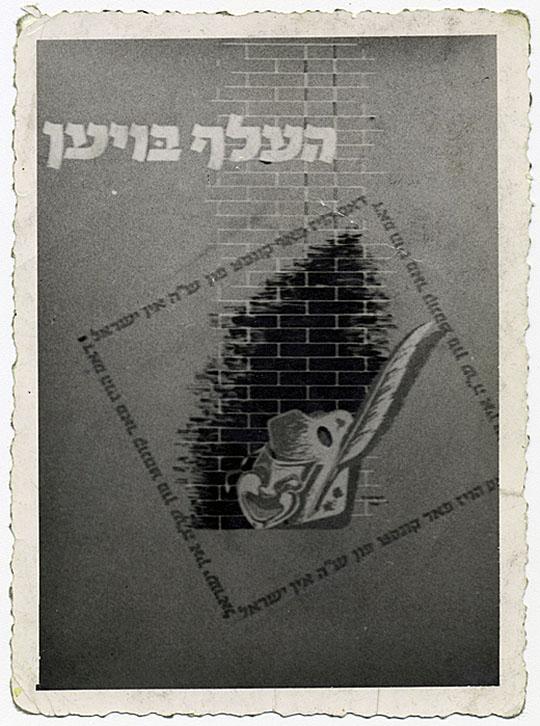Poster created by Pinchas Shaar and encouraging people to donate funds to built a house for the arts in IsraelSource: USHMMhttp://resources.ushmm.org/inquery/uia_doc.php/photos/6282?hr=null[Photograph #25660]
Pinchas Szwarc (later Shaar) was born on March 15, 1923 in Lodz, Poland. He grew up in a middle class family and his father, Jakub, was a carpenter. Pinchas had two brothers, Josef and Lajb, and a sister, Ester Ita. From an early age, Pinchas developed an interest for drawing. At 16 he met the Polish painter Wlasdyslaw Strzeminski, a disciple of the Russian revolutionary painter Malevitch. Strzeminski encouraged Pinchas' artistic education and introduced him to the works of such painters as Picasso, Leger, Matisse, and Mondrian. Pinchas had his first exhibit in 1938. However, when Nazi Germany invaded Poland the following year, Pinchas' budding artistic career came to an end. On February 1940 the Jews of Lodz had to move to a ghetto and perform forced labor. Pinchas worked in a prefabricated furniture factory. However, after his artistic abilities were discovered, he became a draftsman. He also designed decorations for the ghetto's theater. In 1944 the Germans liquidated the Lodz ghetto and deported its inhabitants to concentration camps. Pinchas, his brothers and his father were sent to Sachsenhausen. After his liberation by the Soviet Army in 1945, Pinchas was fortunate to reunite with his parents and his two brothers. Unfortunately Pinchas' sister and her child perished in a Nazi camp. After the war Pinchas decided that he couldn't remain in the city that had hosted so much suffering and was the first of his family to leave Poland. Before continuing towards the West, Pinchas stopped in a sanatorium in Gauting, Germany. There, Pinchas returned to art after a nurse brought him brushes and paint-boxes. This daily artistic activity permitted him to quickly regain his moral and physical strength. After leaving the sanatorium, Pinchas moved to Munich, where he stayed until November 1947. From Munich he went to Paris where his artistic strength and originality fully developed. The contact with both old masters and new and revolutionary artists encouraged Pinchas to develop his own personal perceptions. But Pinchas' family, who had already settled in Israel, wanted him to join them there. In 1953 he moved to Israel where he became an internationally renowned artist. Pinchas spent his life between Paris, Israel and New York where he died in 1996Source: USHMM
http://resources.ushmm.org/inquery/uia_doc.php/photos/6282?hr=null

